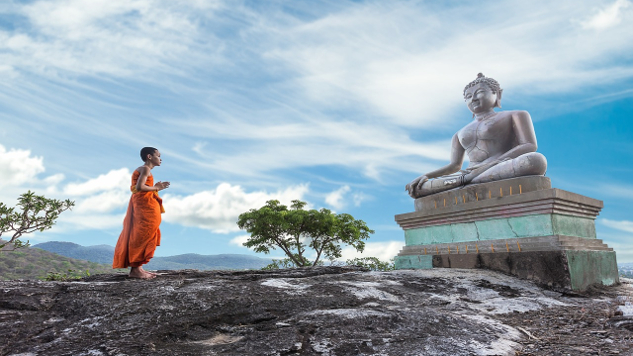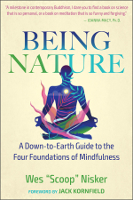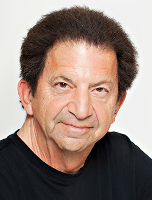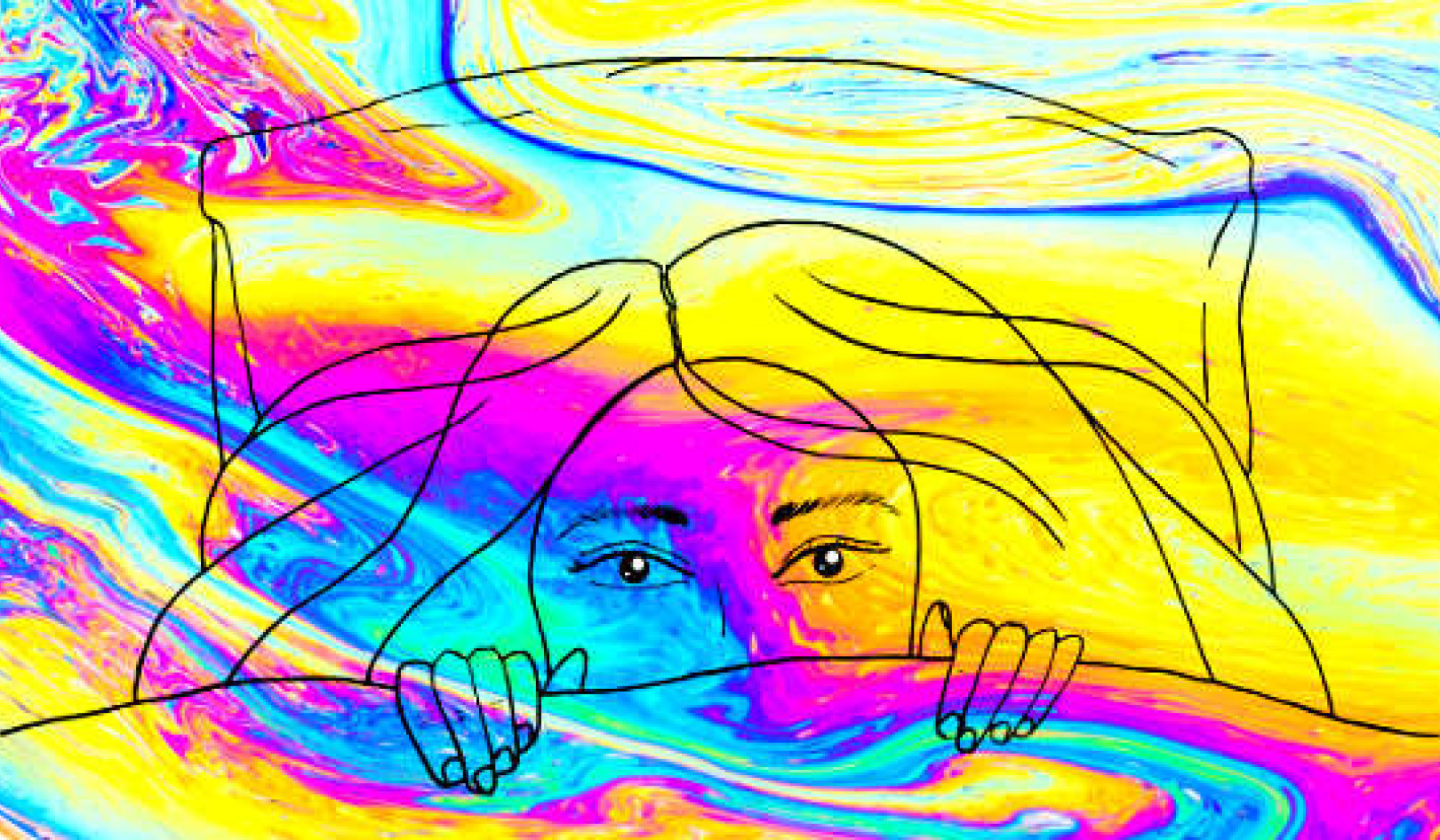
Image by Sasin Tipchai
Buddhist meditation practices and scientific exploration reveal two ways of knowing. With the scientific method, we look outside of ourselves for truth, dividing up the world to see if reality’s secrets are hiding in the cracks. Meanwhile, with meditation, we direct our attention inward, relying on experiential knowing, seeking to resolve the questions themselves in the realization of non-duality and the great mystery of consciousness.
As they compare notes, scientists and Buddhist scholars alike have been astounded by the fact that the two ways of knowing have arrived at so many similar conclusions. Physics is one arena where the two have found agreement. As impossible as it must seem to physicists who use sophisticated bubble chambers and laser photography to study sub-atomic events, Buddhists have uncovered at least the basic principles of subatomic physics through their meditation practices.
Meditation can reveal that there is no solidity anywhere, that the observer cannot be separated from what is observed, that phenomena seem to appear out of emptiness, and that everything affects everything else in a co-emergent system that scientists have acknowledged and named “nonlocality.” These insights have been discovered by many meditators who have simply focused their attention inward.
The Buddhist and scientific maps of mind and cognition are strikingly similar. Furthermore, the Buddhists have for centuries been studying the elusive nature of “self ” and consciousness, concepts that continue to befuddle the neuroscientists. Many Buddhists have even resolved these puzzles, at least to the individual meditator’s satisfaction.
Buddhist meditation: a form of scientific research
Buddhist meditation itself could be understood as a form of scientific research. Meditators try to maintain the scientific attitude of objectivity while investigating themselves. They too want to look at life without prejudicing the study with personal desires or preset theories. “Just the facts, ma’am.”
A scientist might argue that his findings are objective because they can be verified by someone replicating the experiments or redoing the mathematical equations. However, every Buddhist meditator who undertakes a specific path of inquiry is, in a sense, redoing the experiment, and most will arrive at similar conclusions about the nature of self and reality. In mindfulness meditation, what is known as “the progress of insight” unfolds in a relatively standard fashion for most people.
The Buddha wants each of us to become a scientist, using ourselves as subjects. He recommends a careful deconstruction of the seemingly solid realities of mind and body as a way to explore their sources, and thus reveal our oneness with the world. As it says in the Abhidhamma, an early Buddhist text, “the first task of insight (vipassana) meditation is . . . the dissecting of an apparently compact mass.”
Modern science also set about the task of disassembling reality and has found—miracle of miracles—that oneness is right there, in reality’s very core. If it has proven anything, scientific research over the past few decades has validated the mystical vision as the ultimate truth. Nothing can be separated from anything else. The scientists attempt to express this oneness by inserting the connector: wave-particle, space-time, matter-energy.
Although modern science has helped humanity achieve new levels of material comfort, its greatest gift may yet turn out to be spiritual—a more accurate and satisfying way of understanding ourselves. Instead of reducing humans to material processes, as some critics assert, scientists are simply showing us the specific threads that connect us to all of life and the universe.
A single protein molecule or a single finger print, a single syllable on the radio or a single idea of yours implies the whole historical reach of stellar and organic evolution. It is enough to make you tingle all the time. -- John Platt, The Steps to Man.
The Buddha: a scientist of the self
The Buddha was a great scientist of the self. It is clear in the P?li Canon that he was not much concerned with cosmic consciousness, and there is no evidence that he believed in any god or goddess. He was also silent on the question of a first cause, saying it would be impossible to trace the “karma,” the complete history of either an individual or the universe. Instead, throughout his discourses we find the Buddha emphasizing what I would call “biological consciousness.”
The Buddha’s meditation instructions in the P?li Canon are almost exclusively focused on the natural processes of our physical and mental life. He tells us to meditate on our skin and bones, our nervous system, the processes of walking, hearing, seeing, and thinking. According to the Buddha, everything we need to know about life and reality can be found inside “this fathom-long body.” The Buddha tells us to become personally familiar with this truth by meditating on the changes that take place inside of us at every moment:
Throughout his teachings, for instance, the Buddha emphasizes the impermanent nature of all phenomena. Remembering this universal truth (documented from Heraclitus to Heisenberg) is critical to our personal happiness, because the fact that everything is in transition means that we can’t hold on to any object or experience, nor to life itself. If we forget about impermanence and try to grasp or hold on to things, we will inevitably create suffering for ourselves.
According to the Buddha, by experiencing our own impermanent nature—by feeling it and reflecting upon it regularly—we can learn to inhabit this truth and live by it. As we grow familiar with the radical impermanence of every moment’s experience, we may no longer get so lost in our own desire system; we don’t hold on as tightly or get so “hung up.” We are able to live more in harmony with the way things are. This is one example of how the Buddha was able to use his scientific insights in the service of spirituality.
Those who drink of the deepest truths live happily with a serene mind.
Dhammapada
The Buddha: a spiritual biologist
As a spiritual biologist, the Buddha studied the human condition thoroughly. He gave a broad outline of his findings in the Four Noble Truths, the first of which announces that life is inherently unsatisfactory, a time of continual neediness and desire accompanied by some measure of pain, sadness, sickness, and inevitable old age and death.
The First Noble Truth (dukkha in Pali, translated as “suffering”) is part of the deal when we get a human body and nervous system—period. Critics cite the First Noble Truth as proof that the Buddha was negative about life, but he was simply making a scientific observation.
This human condition may seem inhumane to us, but that only means that it doesn’t meet our standards of fairness. We would like life to be different, and ironically, that desire itself can become a major source of our suffering.
All of this isn’t to deny that there is joy, love, pleasure, and fun in a life, but the hard facts are much more certain. It simply is not easy having a body, fighting gravity from morning to night, being forever in need of food, warmth, and shelter, and driven by the urge to procreate. These are the biological conditions we are born into, and what the Buddha saw was that we need to come to a deep inner understanding and acceptance of them if we are ever to find any peace of mind or ease in life. Indeed, meditators often report feelings of great relief when they begin to acknowledge the First Noble Truth—and that it does apply to them.
The Buddha’s Second Noble Truth (samudaya in Pali, translated as “arising”) attributes the arising of human suffering to the fact that we live in an almost constant state of desire. According to the Buddha, we are born into this condition as well: It is part of our evolutionary inheritance, the karma of taking form.
He explains in detail how simply having a body and senses and coming into contact with the world will create pleasant or unpleasant sensations that will automatically lead to reactions of desire or aversion. This process is instinctual, a function of our nervous system, which operates according to the biological law of stimulus-response. The Buddha saw that this organic condition keeps us continually dissatisfied and off-balance.
With great psychological insight, the Buddha recognized that our desires fall into three categories. One he called the “desire for existence,” which we might think of as the survival instinct, which gets translated into building strong walls around our houses, opening a savings account, finding good doctors, or even seeking a religion that will promise the ultimate security of everlasting life.
The Buddha also saw a complementary desire within us for “nonexistence,” which can be translated into the urge to lose oneself in sex, food, movies, or adventure, or by some means to “get out” of oneself. Even the mys- tical search can be seen as a desire for nonexistence, a wish to dissolve once again into the amniotic fluids or the oceanic Oneness.
The Buddha’s last category of desire is for sense pleasure, perhaps the easiest to notice. It’s the pleasure principle, present in almost everything we do.
I am always startled when I watch my mind for any length of time in meditation, just to discover that these three desire gears are all there, going around independently, with an ever-changing array of objects attached to them. Desire is perfectly natural, I discover, but it has less to do with “me” than I ever could imagine.
Like most people, I usually believe that I suffer only because the desire of this moment remains unfulfilled, until, perhaps in meditation, I recognize that I am caught on a treadmill. When my mind grows quiet, I am able to see that desire itself is what keeps me dissatisfied. This is difficult to notice, precisely because so few moments of our life are without desire. Meditation can offer an experience of another possibility.
There is nothing more important to true growth than realizing that you are not the voice of the mind—you are the one who hears it. -- Michael A. Singer, The Untethered Soul
The Buddha’s Third Noble Truth (nirodha in Pali, translated as “cessation”) is his most significant biological insight, that nature has given us the ability to train our minds to bring us new levels to end suffering and attain freedom and satisfaction. During his own awakening, the Buddha realized that as humans we are able to see into our primal reactivity and in the process learn how to gain some freedom from it.
Evolution has gifted us with the potential for new degrees of self-awareness, and perhaps even the ability, on some level, to take part in our own evolution. If we learn how to develop this potential, we might yet live up to our self-applied labels of “conscious,” or Homo sapiens sapiens, the twice-knowing human. We may even be able to find a way to become a more contented species. “I teach one thing and one thing only,” said the Buddha: “suffering, and the end of suffering.”
The Buddha’s Fourth Noble Truth (magga in Pali, translated as “path”) is the most important one of all, because it tells us how to end our suffering. In this fourth and final truth the Buddha explains how to live a life that does not cause harm to others, partially so that the mind, undisturbed by remorse, guilt, or anger, remains open to the task of self-investigation. The Buddha then gives the basic instructions for developing the vital skills of concentration and mindfulness and explains how to apply these in meditation in order to realize our true nature. This is the Path Leading to the Cessation of Suffering.
Copyright ©2022. All Rights Reserved.
Reprinted with permission. of the publisher,
Inner Traditions Intl.
Article Source: Being Nature
Being Nature: A Down-to-Earth Guide to the Four Foundations of Mindfulness
by Wes "Scoop" Nisker. Using the traditional Buddhist meditation series of the Four Foundations of Mindfulness as a framework, Wes Nisker offers a witty narrative along with practical meditations and exercises to train the mind to overcome painful conditioning and gain greater self-awareness, increased wisdom, and happiness. He shows how recent discoveries in physics, evolutionary biology, and psychology express in scientific terms the same insights the Buddha discovered more than 2,500 years ago, such as the impermanence of the body, where thoughts come from, and how the body communicates within itself.
Using the traditional Buddhist meditation series of the Four Foundations of Mindfulness as a framework, Wes Nisker offers a witty narrative along with practical meditations and exercises to train the mind to overcome painful conditioning and gain greater self-awareness, increased wisdom, and happiness. He shows how recent discoveries in physics, evolutionary biology, and psychology express in scientific terms the same insights the Buddha discovered more than 2,500 years ago, such as the impermanence of the body, where thoughts come from, and how the body communicates within itself.
Presenting a variety of new ways to harness the power of mindfulness to transform our understanding of both ourselves and the world, Nisker teaches us how to put our understanding of evolution in the service of spiritual awakening.
Click here for more info and/or to order this paperback book. Also available as a Kindle edition.
About the Author
 Wes “Scoop” Nisker is an award-winning broadcast journalist and commentator. He has been a meditation teacher since 1990 and leads mindfulness retreats internationally. The author of many books, including The Essential Crazy Wisdom, he is founding coeditor of The Inquiring Mind, an international Buddhist journal, and he is also a standup “dharma comic.”
Wes “Scoop” Nisker is an award-winning broadcast journalist and commentator. He has been a meditation teacher since 1990 and leads mindfulness retreats internationally. The author of many books, including The Essential Crazy Wisdom, he is founding coeditor of The Inquiring Mind, an international Buddhist journal, and he is also a standup “dharma comic.”
Visit his website at WesNisker.com/
More Books by the author.


























